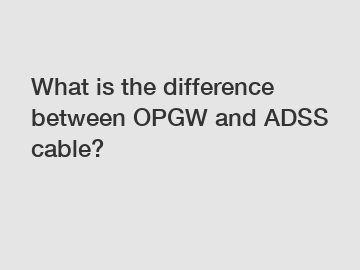What is the difference between OPGW and ADSS cable?
What is the difference between OPGW and ADSS cable?
When it comes to overhead power transmission lines, two types of cables are commonly used - Optical Ground Wire (OPGW) and All-Dielectric Self-Supporting (ADSS) cable. The fundamental difference between OPGW and ADSS lies in their construction and the purpose they serve in the power transmission industry.
OPGW cables are constructed by placing optical fibers in the center of a steel or aluminum tube, surrounded by one or more layers of metal and fiber optic yarns. These cables are designed to serve a dual purpose - providing lightning protection to the transmission line while also functioning as a medium for optical communication. The metallic components of OPGW cables provide a low impedance path for lightning strikes, protecting the transmission line and other electrical apparatus. At the same time, the optical fibers within the cable enable the transmission of data across long distances, facilitating various applications such as telecommunication, SCADA (Supervisory Control and Data Acquisition) systems, and fiber-to-the-home services.

On the other hand, ADSS cables are purely dielectric in nature, meaning they do not contain any metallic parts. They are typically constructed by placing optical fibers inside a central tube, which is then surrounded by layers of water-blocking materials and aramid yarn. ADSS cables are primarily used for optical communication purposes. Unlike OPGW cables, which serve as both power conductors and communication mediums, ADSS cables are installed alongside existing power lines without any electrical contact. This design eliminates the need for grounding the cable and also reduces the risk of electrical faults.
The choice between OPGW and ADSS cables depends on various factors such as the specific requirements of the power transmission line, the expected lightning strikes in the area, and the need for optical communication. OPGW cables are preferred in areas prone to lightning strikes, as their metallic components provide excellent protection to the transmission line. Additionally, OPGW cables offer high bandwidth capacity, making them suitable for applications requiring extensive optical communication.
ADSS cables, on the other hand, are better suited for transmission lines that do not require lightning protection or are located in areas with low lightning strike frequency. Since they do not have any metallic components, ADSS cables are more cost-effective and easier to install, as they do not require grounding. They also provide greater flexibility in terms of installation, as they can be installed on existing power lines without any modification.
In conclusion, the difference between OPGW and ADSS cables lies in their construction, with OPGW offering lightning protection and optical communication capabilities, while ADSS is purely for optical communication. The choice between the two depends on the specific requirements of the power transmission line and the need for lightning protection. Understanding these differences allows power transmission companies to make informed decisions about the most suitable cable type for their projects.
Contact us to discuss your requirements of what is adss, joint box opgw, what is opgw cable. Our experienced sales team can help you identify the options that best suit your needs.
152
0
0


Comments
All Comments (0)